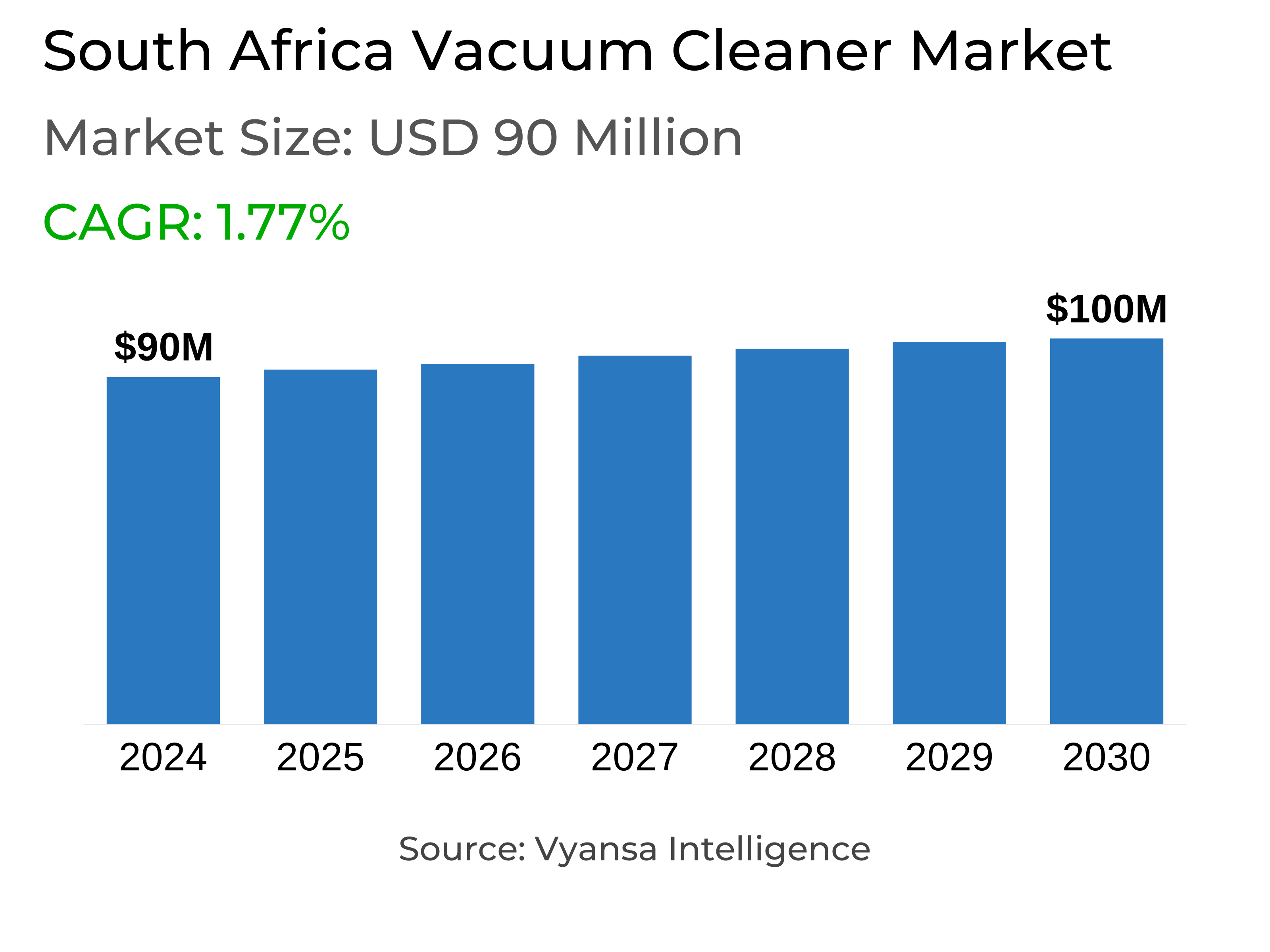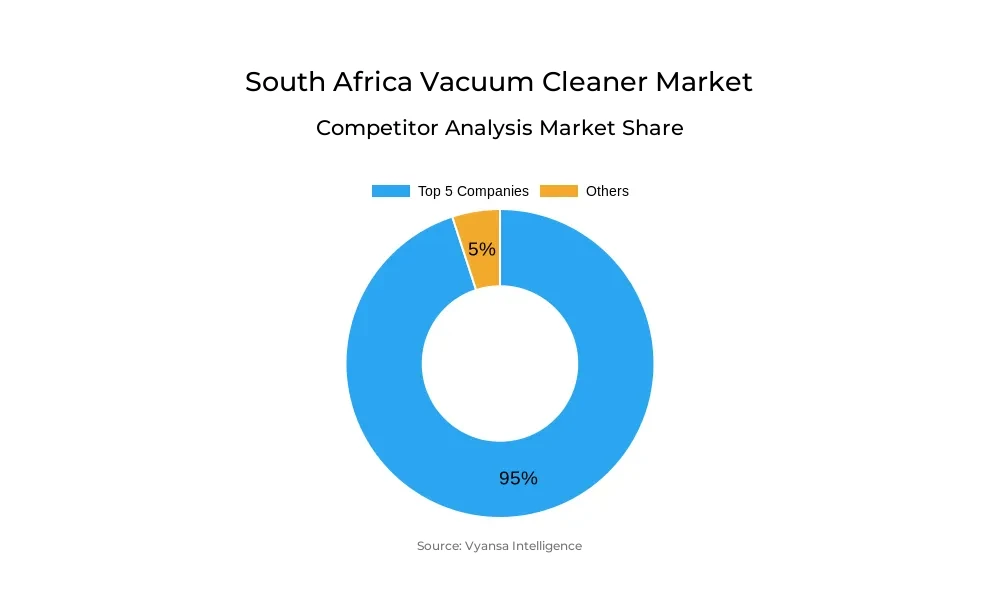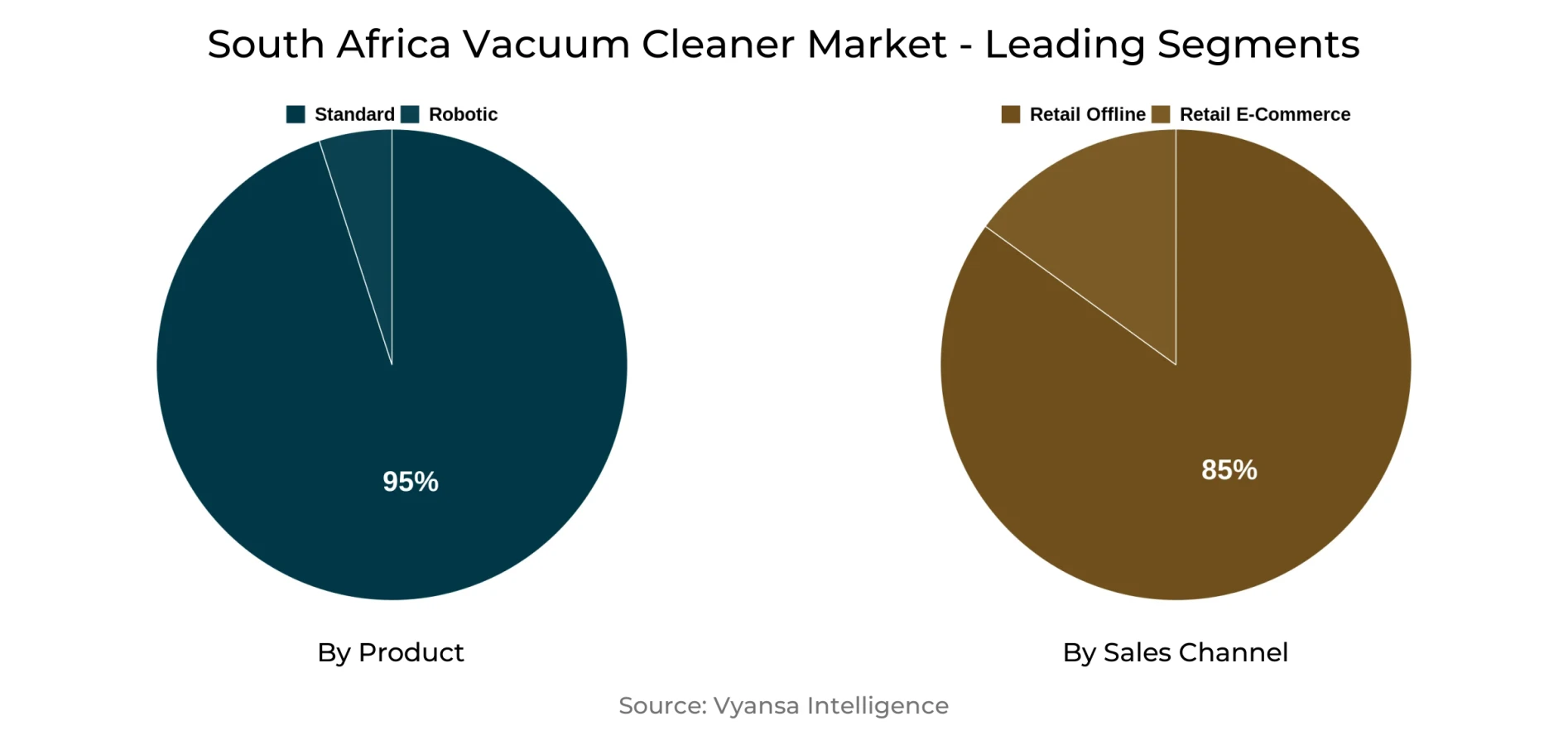
South Africa Vacuum Cleaner Market Report: Trends, Growth and Forecast (2025-2030)
By Product (Standard, Robotic), By Smart Appliances (Smart, Non-Smart), By Power Source (Corded, Cordless), By Sales Channel (Retail Offline, Retail E-Commerce), By End User (Industrial, Residential, Commercial)
- FMCG
- Oct 2025
- VI0016
- 127
-




South Africa Vacuum Cleaner Market Statistics, 2025
- Market Size Statistics
- Vacuum Cleaner in South Africa is estimated at $ 90 Million.
- The market size is expected to grow to $ 100 Million by 2030.
- Market to register a CAGR of around 1.77% during 2025-30.
- Product Shares
- Standard Vacuum Cleaners grabbed market share of 95%.
- Standard Vacuum Cleaners to witness a volume CAGR of around 4.63%.
- Competition
- More than 5 companies are actively engaged in producing Vacuum Cleaner in South Africa.
- Top 5 companies acquired 95% of the market share.
- Tudortech (Pty) Ltd, Miele (Pty) Ltd, Home of Living Brands (Pty) Ltd, Tevo (Pty) Ltd, Verimark (Pty) Ltd etc., are few of the top companies.
- Sales Channel
- Retail Offline grabbed 85% of the market.
South Africa Vacuum Cleaner Market Outlook
In 2024, the South Africa vacuum cleaners market is still seeing strong retail volume growth due to changing consumer lifestyles and rising interest in health and wellness. Cylinder vacuum cleaners lead as the most widely used format, with upright and steam formats following behind. The rise of multifunctional wet and dry versions, as well as pet-specific models from the likes of Dyson and Miele, is also further driving household penetration.
Robotic vacuum cleaners are emerging as the most dynamic performer, albeit from a low base, fueled by rising demand for convenience and smart home integration. Xiaomi Mi’s launch of the S20 and S20+ models in 2024, featuring strong suction power, mopping capabilities, long battery life, and smart navigation, highlights the segment’s growing importance. These affordable smart devices, compatible with voice assistants and mobile apps, are expected to broaden the consumer base.
Three major players—Bennett Read, Genesis, and Hoover—dominate the competitive environment with a total of 92% retail volume share. They provide a wide variety of formats and price points, reaching all income groups. In-store sales people are important in stimulating awareness and facilitating consumer decision-making.
Distribution continues to be dominated by offline trade, such as hypermarkets and electronics specialists, since many prefer to view products in person. E-commerce is growing strongly, though, powered by increasing consumer confidence, ease of price comparison, and regular promotion offers. An omnichannel strategy is expected to be on the rise, with retailers heavily investing in bundled-up platforms that address changing consumer tastes.

South Africa Vacuum Cleaner Market Growth Driver
South African retail volume sales of vacuum cleaners are continuing to enjoy strong momentum in 2024 as a result of changing consumer lifestyles and heightened health consciousness. The greater necessity of having clean, dust-free homes is driving demand across all channels, as cylinder vacuum cleaners continue to be the favorite among consumers, followed by upright and steam models. The introduction of pet-focused models by players such as Dyson and Miele is also contributing to category expansion. Further, the launch of feature-rich multifunctional vacuum cleaners with wet and dry functionalities is facilitating increased market penetration. The robotic vacuum cleaners, while expanding from a lower base, have been the most vibrant segment over the review period. These trends illustrate a decisive shift in consumer demand toward more efficient and specialist cleaning products, setting further the consistent growth of vacuum cleaner uptake among South African homes.
South Africa Vacuum Cleaner Market Trend
Robot vacuum cleaners are also expected to continue to record double-digit retail volume expansion over the forecast period, although from a limited base. This is an indication of their increasing popularity and increasing relevance in the vacuum cleaner market. Although affluent consumers in South Africa are increasingly turning to robotic vacuum cleaners, overall penetration will remain low as a result of their notably higher unit price versus other forms. But with new models from brands such as Xiaomi Mi and Taurus coming into the market, the average price per unit (at constant 2024 prices) will fall, making them affordable. This is assisted by the convenience factor—these devices are able to function on their own once charged up, a big plus considering South Africa's regular load shedding. Time-pinched consumers also appreciate the automation aspect, which enables programmed tasks to execute on their own. The larger trend towards smart home systems is also likely to drive future demand.
South Africa Vacuum Cleaner Market Opportunity
The competitive environment in South Africa is changing with the entry of new brands into the vacuum cleaner market, fueled by the nation's low penetration rate. Yet, inundating the market with models confuses consumers, prompting the need for information-driven advice. To meet the need, brands are sending in-store representatives to help consumers by laying out the product features and advantages. This approach has particularly favored top players such as Bennett Read (Tevo (Pty) Ltd) and Genesis (Verimark (Pty) Ltd), who are experiencing rising retail volume sales. Their concerted efforts at consumer education through in-store interaction are creating brand awareness and influencing buying decisions, a key opportunity in the expanding market.
| Report Coverage | Details |
|---|---|
| Market Forecast | 2025-30 |
| USD Value 2024 | $ 90 Million |
| USD Value 2030 | $ 100 Million |
| CAGR 2025-2030 | 1.77% |
| Largest Category | Standard Vacuum Cleaners segment leads with 95% market share |
| Top Drivers | Rising Demand Backed by Lifestyle Shifts and Health-Conscious Consumers |
| Top Trends | Rising Popularity of Robotic Vacuum Cleaners Amid Load Shedding and Demand for Convenience |
| Top Opportunities | Rising Brand Engagement Through In-Store Assistance Driving Consumer Awareness |
| Key Players | Tudortech (Pty) Ltd, Miele (Pty) Ltd, Home of Living Brands (Pty) Ltd, Tevo (Pty) Ltd, Verimark (Pty) Ltd and Others. |
South Africa Vacuum Cleaner Market Segmentation Analysis

The most penetrated segment in South Africa Vacuum Cleaner Market is retail offline, more specifically hypermarkets and appliances and electronics specialists. These formats are still leaders since much of the population values shopping in stores to try the product, compare models, and obtain advice from an expert prior to buying. In spite of this leadership, e-commerce is growing remarkably well and should further gain momentum in the forecast period. Growing consumer confidence in e-commerce, as well as the possibility to compare prices and receive frequent promotions on platforms such as Takealot, is fueling this trend. Therefore, an increasing more omnichannel purchase behavior is arising, whereby consumers browse products offline but make purchases online for a better deal. Retailers are fighting back by heavily investing in omnichannel platforms to support changing consumer needs and give them an improved overall shopping experience.
Top Companies in South Africa Vacuum Cleaner Market
The top companies operating in the market include Tudortech (Pty) Ltd, Miele (Pty) Ltd, Home of Living Brands (Pty) Ltd, Tevo (Pty) Ltd, Verimark (Pty) Ltd, etc., are the top players operating in the South Africa Vacuum Cleaner Market.
Frequently Asked Questions
Related Report
1. Market Segmentation
1.1. Research Scope
1.2. Research Methodology
1.3. Definitions and Assumptions
2. Executive Summary
3. South Africa Vacuum Cleaner Market Policies, Regulations, and Standards
4. South Africa Vacuum Cleaner Market Dynamics
4.1. Growth Factors
4.2. Challenges
4.3. Trends
4.4. Opportunities
5. South Africa Vacuum Cleaner Market Statistics, 2020-2030F
5.1. Market Size & Growth Outlook
5.1.1.By Revenues in US$ Million
5.1.2.By Unit Sold in Thousand Units
5.2. Market Segmentation & Growth Outlook
5.2.1.By Product
5.2.1.1. Standard- Market Insights and Forecast, 2020-2030, USD Million
5.2.1.1.1. Cylinder- Market Insights and Forecast, 2020-2030, USD Million
5.2.1.1.2. Handheld- Market Insights and Forecast, 2020-2030, USD Million
5.2.1.1.3. Stick- Market Insights and Forecast, 2020-2030, USD Million
5.2.1.1.4. Upright- Market Insights and Forecast, 2020-2030, USD Million
5.2.1.1.5. Steam- Market Insights and Forecast, 2020-2030, USD Million
5.2.1.2. Robotic- Market Insights and Forecast, 2020-2030, USD Million
5.2.2.By Smart Appliances
5.2.2.1. Smart- Market Insights and Forecast, 2020-2030, USD Million
5.2.2.2. Non-Smart- Market Insights and Forecast, 2020-2030, USD Million
5.2.3.By Power Source
5.2.3.1. Corded- Market Insights and Forecast, 2020-2030, USD Million
5.2.3.2. Cordless- Market Insights and Forecast, 2020-2030, USD Million
5.2.4.By Sales Channel
5.2.4.1. Retail Offline- Market Insights and Forecast, 2020-2030, USD Million
5.2.4.1.1. Grocery Retailers- Market Insights and Forecast, 2020-2030, USD Million
5.2.4.1.1.1. Hypermarkets- Market Insights and Forecast, 2020-2030, USD Million
5.2.4.1.2. Non-Grocery Retailers- Market Insights and Forecast, 2020-2030, USD Million
5.2.4.1.2.1. General Merchandise Stores- Market Insights and Forecast, 2020-2030, USD Million
5.2.4.1.2.1.1. Department Stores- Market Insights and Forecast, 2020-2030, USD Million
5.2.4.1.2.1.2. Variety Stores- Market Insights and Forecast, 2020-2030, USD Million
5.2.4.1.2.2. Appliances and Electronics Specialists- Market Insights and Forecast, 2020-2030, USD Million
5.2.4.1.2.3. Home Products Specialists- Market Insights and Forecast, 2020-2030, USD Million
5.2.4.2. Retail E-Commerce- Market Insights and Forecast, 2020-2030, USD Million
5.2.5.By End User
5.2.5.1. Industrial- Market Insights and Forecast, 2020-2030, USD Million
5.2.5.2. Residential- Market Insights and Forecast, 2020-2030, USD Million
5.2.5.3. Commercial- Market Insights and Forecast, 2020-2030, USD Million
5.2.6.By Competitors
5.2.6.1. Competition Characteristics
5.2.6.2. Market Share & Analysis
6. South Africa Standard Vacuum Cleaner Market Outlook, 2020-2030F
6.1. Market Size & Growth Outlook
6.1.1.By Revenues in US$ Million
6.1.2.By Unit Sold in Thousand Units
6.2. Market Segmentation & Growth Outlook
6.2.1.By Product - Market Insights and Forecast, 2020-2030, USD Million
6.2.2.By Smart Appliances- Market Insights and Forecast, 2020-2030, USD Million
6.2.3.By Power Source- Market Insights and Forecast, 2020-2030, USD Million
6.2.4.By Sales Channel- Market Insights and Forecast, 2020-2030, USD Million
6.2.5.By End User- Market Insights and Forecast, 2020-2030, USD Million
7. South Africa Robotic Vacuum Cleaner Market Outlook, 2020-2030F
7.1. Market Size & Growth Outlook
7.1.1.By Revenues in US$ Million
7.1.2.By Unit Sold in Thousand Units
7.2. Market Segmentation & Growth Outlook
7.2.1.By Smart Appliances- Market Insights and Forecast, 2020-2030, USD Million
7.2.2.By Power Source- Market Insights and Forecast, 2020-2030, USD Million
7.2.3.By Sales Channel- Market Insights and Forecast, 2020-2030, USD Million
7.2.4.By End User- Market Insights and Forecast, 2020-2030, USD Million
8. Competitive Outlook
8.1. Company Profiles
8.1.1.Tudortech (Pty) Ltd
8.1.1.1. Business Description
8.1.1.2. Product Portfolio
8.1.1.3. Collaborations & Alliances
8.1.1.4. Recent Developments
8.1.1.5. Financial Details
8.1.1.6. Others
8.1.2.Miele (Pty) Ltd
8.1.2.1. Business Description
8.1.2.2. Product Portfolio
8.1.2.3. Collaborations & Alliances
8.1.2.4. Recent Developments
8.1.2.5. Financial Details
8.1.2.6. Others
8.1.3.Home of Living Brands (Pty) Ltd
8.1.3.1. Business Description
8.1.3.2. Product Portfolio
8.1.3.3. Collaborations & Alliances
8.1.3.4. Recent Developments
8.1.3.5. Financial Details
8.1.3.6. Others
8.1.4.Tevo (Pty) Ltd
8.1.4.1. Business Description
8.1.4.2. Product Portfolio
8.1.4.3. Collaborations & Alliances
8.1.4.4. Recent Developments
8.1.4.5. Financial Details
8.1.4.6. Others
8.1.5.Verimark (Pty) Ltd
8.1.5.1. Business Description
8.1.5.2. Product Portfolio
8.1.5.3. Collaborations & Alliances
8.1.5.4. Recent Developments
8.1.5.5. Financial Details
8.1.5.6. Others
9. Disclaimer
| Segment | Sub-Segment |
|---|---|
| By Product |
|
| By Smart Appliances |
|
| By Power Source |
|
| By Sales Channel |
|
| By End User |
|
Research Methodology
This study followed a structured approach comprising four key phases to assess the size and scope of the electro-oxidation market. The process began with thorough secondary research to collect data on the target market, related markets, and broader industry context. These findings, along with preliminary assumptions and estimates, were then validated through extensive primary research involving industry experts from across the value chain. To calculate the overall market size, both top-down and bottom-up methodologies were employed. Finally, market segmentation and data triangulation techniques were applied to refine and validate segment-level estimations.
Secondary Research
The secondary research phase involved gathering data from a wide range of credible and published sources. This step helped in identifying industry trends, defining market segmentation, and understanding the market landscape and value chain.
Sources consulted during this phase included:
- Company annual reports, investor presentations, and press releases
- Industry white papers and certified publications
- Trade directories and market-recognized databases
- Articles from authoritative authors and reputable journals
- Gold and silver standard websites
Secondary research was critical in mapping out the industry's value chain and monetary flow, identifying key market segments, understanding regional variations, and tracking significant industry developments.
Other key sources:
- Financial disclosures
- Industry associations and trade bodies
- News outlets and business magazines
- Academic journals and research studies
- Paid industry databases
Primary Research
To validate secondary data and gain deeper market insights, primary research was conducted with key stakeholders across both the supply and demand sides of the market.
On the demand side, participants included decision-makers and influencers from end-user industries—such as CIOs, CTOs, and CSOs—who provided first-hand perspectives on market needs, product usage, and future expectations.
On the supply side, interviews were conducted with manufacturers, industry associations, and institutional participants to gather insights into current offerings, product pipelines, and market challenges.
Primary interviews provided critical inputs such as:
- Market size and revenue data
- Product and service breakdowns
- Market forecasts
- Regional and application-specific trends
Stakeholders consulted included:
- Leading OEM and solution providers
- Channel and distribution partners
- End users across various applications
- Independent consultants and industry specialists
Market Size Estimation and Data Triangulation
- Identifying Key Market Participants (Secondary Research)
- Goal: To identify the major players or companies in the target market. This typically involves using publicly available data sources such as industry reports, market research publications, and financial statements of companies.
- Tools: Reports from firms like Gartner, Forrester, Euromonitor, Statista, IBISWorld, and others. Public financial statements, news articles, and press releases from top market players.
- Extracting Earnings of Key Market Participants
- Goal: To estimate the earnings generated from the product or service being analyzed. This step helps in understanding the revenue potential of each market player in a specific geography.
- Methods: Earnings data can be gathered from:
- Publicly available financial reports (for listed companies).
- Interviews and primary data sources from professionals, such as Directors, VPs, SVPs, etc. This is especially useful for understanding more nuanced, internal data that isn't publicly disclosed.
- Annual reports and investor presentations of key players.
- Data Collation and Development of a Relevant Data Model
- Goal: To collate inputs from both primary and secondary sources into a structured, data-driven model for market estimation. This model will incorporate key market KPIs and any independent variables relevant to the market.
- Key KPIs: These could include:
- Market size, growth rate, and demand drivers.
- Industry-specific metrics like market share, average revenue per customer (ARPC), or average deal size.
- External variables, such as economic growth rates, inflation rates, or commodity prices, that could affect the market.
- Data Modeling: Based on this data, the market forecasts are developed for the next 5 years. A combination of trend analysis, scenario modeling, and statistical regression might be used to generate projections.
- Scenario Analysis
- Goal: To test different assumptions and validate how sensitive the market is to changes in key variables (e.g., market demand, regulatory changes, technological disruptions).
- Types of Scenarios:
- Base Case: Based on current assumptions and historical data.
- Best-Case Scenario: Assuming favorable market conditions, regulatory environments, and technological advancements.
- Worst-Case Scenario: Accounting for adverse factors, such as economic downturns, stricter regulations, or unexpected disruptions.
Partnering With Industry Leaders to Drive Growth
Our mission is to deliver intelligence that matters. By combining data, analysis, and industry expertise, we enable organizations to make smarter, faster, and more impactful decisions. Whether it’s a Fortune 500 company or a high-growth startup, businesses trust us to provide clarity in an ever-evolving marketplace.






